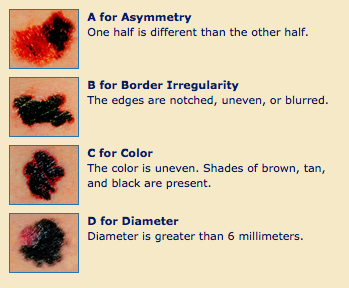Skin cancer is lurking around every ill-shaded, ultraviolet-flooded afternoon. Is your skin protected from this potential killer? Determine the need for medical attention by learning your ABCDs.
Skin cancer comes in many shapes and colors, the more abnormal, the more important it is to have questionable growths checked by a medical professional. Holland dermatologist Suzette Sanchez says irregularity in size, border, and color are key indicators of something dangerous. Even existing moles are not immune to contracting the disease.
"In general, an existing mole has around 10 percent chance of turning into something suspicious during a lifetime," Dr. Sanchez says.
Likewise, women are slightly more likely to be diagnosed with melanoma–the most deadly form of skin cancer, especially during the ages of 18-30, and "a general rule is that if you've had one skin cancer, you are prone to another within the next five years," Dr. Sanchez says.
The most common forms of skin cancer are basal cell carcinoma, a slow-growing and localized form of the disease; squamous cell carcinoma, which spreads more aggressively; and melanoma. Melanoma can be deadly because of its aptness to spread to other organs and parts of the body like bones, brain, lungs, and liver, Dr. Sanchez says.
While fair-skin is more prone to skin cancer than darker complexions, olive-toned women should still lather on the sun block. "Bob Marley died of skin cancer," Dr. Sanchez reminds.
Although a trained dermatologist eye is ideal, there are ways to stay on the look out for potential cancerous moles at home. According to the American Melanoma Foundation, "a sudden or continuous change in the appearance of a mole is a sign that you should see your doctor. The ABCD rule can help you remember the symptoms of melanoma." What are the ABCDs of skin cancer?

Other possible symptoms include tenderness, itching, bleeding, oozing, scaly appearance, a new bump or nodule, spreading color, and redness or swelling that goes beyond the perimeter of the mole, the AMF says.
Skin cancer, if caught early on, can be surgically removed. When in doubt, check with your doctor.
Written by: Erika Fifelski is the West Michigan Woman magazine editorial coordinator. She was born and raised in West Michigan, and after a brief stint on the sunrise side, she's home and loving it. Erika enjoys gardening, vacuuming, and discovering new ways to live sustainably and support local businesses. Photos: American Melanoma Foundation, Marek Bernat




